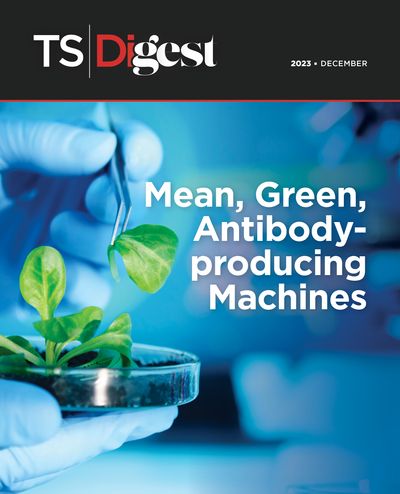Mean, Green, Antibody-producing Machines
A plant-based monoclonal antibody goes head-to-head with its commercial counterpart to target tumors in mice.
Plants are incredible organisms that may soon have a new function: producing monoclonal antibodies. Plant-made antibodies against viral diseases generated immunity in mice and nonhuman primates.1-3 While some researchers showed the tumor targeting potential of these antibodies in cancer models, few demonstrated their antitumor activity in vivo.4,5
Waranyoo Phoolcharoen, a plant molecular biologist at Chulalongkorn University, and her team set out to do just that. In a recent paper in Scientific Reports, the team reported in vivo tumor growth inhibition from plant-produced atezolizumab, an immune checkpoint inhibitor that binds programmed death ligand 1 (PD-L1) on cancer cells to block their immune suppressive activity.6
"Many groups of researchers try to…study the structures of the antibodies. That's one thing, but [to] confirm that it can reduce tumors in animals, that’s the big thing,” said Phoolcharoen.
To test the activity of plant-produced atezolizumab, the group expressed the monoclonal antibody in an Australian tobacco plant, isolated it, and compared it to its commercial counterpart. The two antibodies were comparable in their size, glycosylation patterns, and binding to human PD-L1 in vitro.
Mice implanted with tumors and treated with either antibody gained weight and reduced tumor size similarly and did so significantly more than nontreated mice.
“Such data are often difficult to come by,” said Johannes Buyler, a bioprocess engineer at the University of Natural Resources and Life Sciences who wasn’t involved in the study. He emphasized that the findings bridge an important gap since comparative studies have been lacking in the field.
Next, Phoolcharoen wants to study the distribution, clearance, and toxicity of plant-produced atezolizumab to eventually take it to clinical trials.
References
- Hurtado J, et al. Plant Biotechnol. J. 2020;18(1):266-273
- Lai H, et al. Proc Natl Acad Sci. 2010;107(6):2419-2424
- Olinger Jr GG, et al. Proc Natl Acad Sci 2012;109(44):18030-18035
- Dent M, et al. Plant Biotechnol J. 2022;20(11):2217-2230
- Ludwig DL, et al. Hum Antibodies. 2004;13(3):81-90
- Rattanapisit A, et al. Sci Rep.2023;13(1):14146


